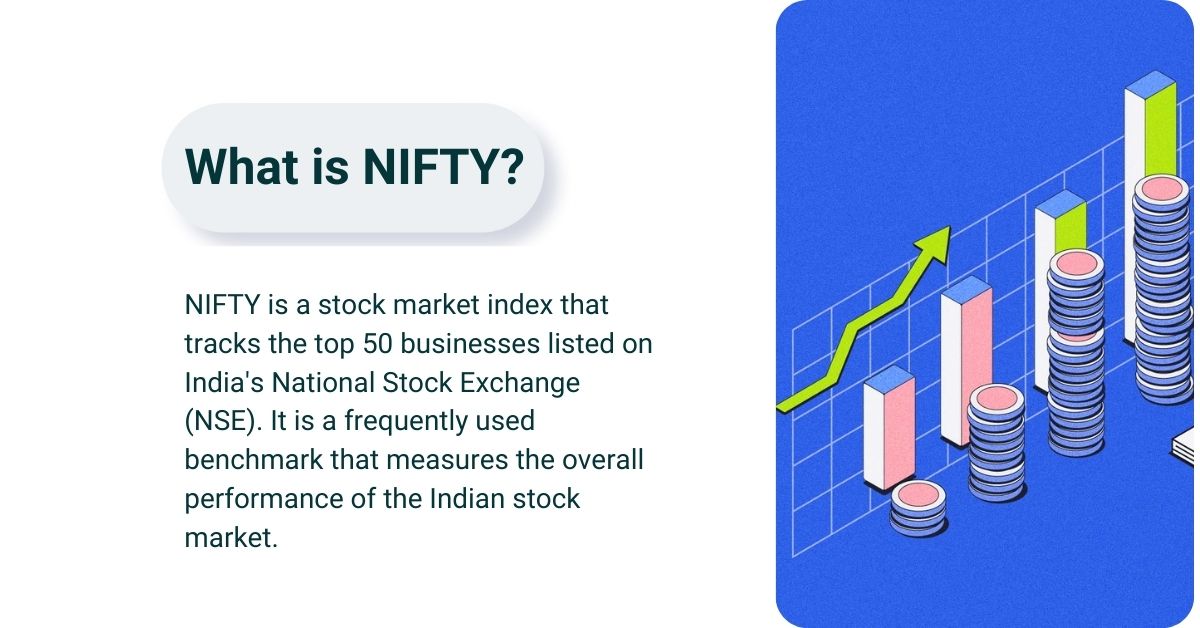NIFTY, or the National Stock Exchange Fifty, is a highly followed benchmark index in India’s financial markets. The National Stock Exchange (NSE) introduced the NIFTY 50 in 1996 to track the performance of the top 50 equity equities listed on the NSE, which are chosen based on their free-float market capitalization and liquidity.
In this article, we’ll cover all you need to know about NIFTY. So, let’s learn more about NIFTY, such as when it was formed, what it means, and so on.
What is NIFTY?

NIFTY is a stock market index that tracks the top 50 businesses listed on India’s National Stock Exchange (NSE). It is a frequently used benchmark that measures the overall performance of the Indian stock market.
By analyzing the movements of these 50 major businesses across multiple industries, NIFTY offers investors a picture of the market’s health and direction. In simple terms, it serves as a barometer for Indian equities, allowing investors to monitor market trends and make informed decisions.
How Does NIFTY Work?
NIFTY serves as the representative of the top 50 largest companies on the Indian stock market. Consider these 50 companies as a team. NIFTY assigns a score to this team depending on how well these companies are performing.
If the majority of companies in this group do well, the NIFTY score rises, indicating a good market trend. Conversely, if numerous companies are struggling, the NIFTY score declines, indicating a downward market trend. This score is regularly updated during the trading day, providing investors with a real-time view of the overall market health.
How is NIFTY Calculated?
NIFTY is calculated using a process known as “free-float market capitalization weighted.” This means that the value of each firm in the index is calculated by multiplying the number of shares available for public trading (free-float shares) by their price.
The NIFTY index value is calculated using the total worth of all 50 companies. Essentially, larger companies with more shares available for trade have a greater influence on the index than smaller companies.
Top Companies NIFTY
The Nifty 50 constituents can change over time based on various factors like market capitalization, liquidity, and other criteria.
However, as of now, some of the prominent companies included in the Nifty 50 index are:
- Reliance Industries is a conglomerate having businesses in oil and gas, petrochemicals, retail, and telecommunications.
- HDFC Bank is one of India’s largest private-sector banks.
- Infosys is a renowned worldwide IT services provider.
- Tata Consultancy Services (TCS) is India’s largest IT services exporter.
- Hindustan Unilever is a major consumer goods company.
- Larsen & Toubro (L&T) is a significant engineering and construction firm.
- ICICI Bank is another major private-sector bank.
These are just a few examples; the Nifty 50 covers a wide range of industries, including banking, finance, IT, energy, FMCG, and others.
What Are the Factors That Cause Changes in the NIFTY?
Numerous reasons drive Nifty volatility. These include economic indices such as GDP growth, inflation, and central bank-set interest rates. Global events, such as trade wars or geopolitical tensions, have an impact on the market. Domestic policy, company earnings, and investor sentiment all have significant influence.
Additionally, the success of individual Nifty constituent firms and their market capitalization have a substantial impact on the index. Essentially, the Nifty is a barometer that measures the aggregate performance of India’s top 50 companies, driven by a complex interaction of domestic and global factors.
Key factors:
- Economic indicators (GDP, inflation, interest rates)
- Global events (trade wars, geopolitical tensions)
- Domestic policies (government initiatives, regulations)
- Corporate earnings
- Investor sentiment
- Performance of individual Nifty stocks
- Market capitalization of constituent companies

